新・東洋館のみどころ
世界有数の東洋美術コレクション
| 東洋館のコレクション総数はおよそ2万件。その幅と質の高さにおいて国内随一を誇ります。中でも、中国の宋・元時代の書画、中国陶磁、中国漆工、西域美術に関しては世界でも有数のコレクションといえます。1月のリニューアルオープン時の注目作品をご紹介します。 |
中国の絵画・中国の書跡中国の書画は日本美術の発展のお手本になってきましたが、そのなかでも最高峰とされるのが宋元時代の書画です。それらは中国で学んで帰国した僧侶や近世の交易活動などによって、日本にもたらされたものでした。なかには、中国ではすでになくなってしまった貴重な作例もあります。当館の中国書画は、足利将軍家が収集した東山御物などの宋元画を中心に、世界の博物館でも他に例をみない、日本と中国の長い交流によって育まれた珠玉のコレクションとなっています。
|
 |
 |
| 国宝 紅白芙蓉図 李迪筆 南宋時代・慶元3年(1197) 李迪は南宋の宮廷画家。時間の経過とともに色を変化させる芙蓉を描き、東洋画の写実主義の頂点に位置する作品です。 (展示期間:2013年1月2日(水)~1月27日(日) 8室) |
国宝 瀟湘臥遊図巻(部分) 李氏筆 南宋時代・12世紀 全体を淡墨で描き、画面全体に吸い込まれていくようです。高い精神性をたたえ、かつて乾隆帝(けんりゅうてい)が所蔵していた四名巻の一つでした。 (展示期間:2013年1月2日(水)~1月27日(日) 8室) |
 |
国宝 碣石調幽蘭第五(部分) |
![]() 「中国の絵画」展示作品リストへ
「中国の絵画」展示作品リストへ
![]() 「中国の書跡」展示作品リストへ
「中国の書跡」展示作品リストへ
中国の陶磁昭和7年(1932)から7回にわたり、建築家の横河民輔によって1100点余の東洋陶磁が寄贈されました。
なかでも中国陶磁はきわめて質が高く、日本を代表するコレクションとして世界に名を知られています。それからおよそ80年。こうした古く歴史ある収蔵品を礎にして、中国陶磁コレクションはいまも前進をつづけています。充実した中国陶磁コレクションに加え、新しい東洋館では陶片、窯道具も展示します。 |
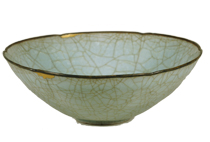 |
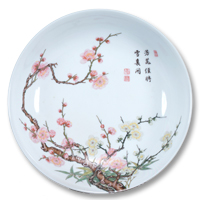 |
|
| 重要文化財 青磁輪花鉢 南宋官窯 南宋時代・12~13世紀 横河民輔氏寄贈 光によって限りなく変化する深遠な青磁の釉色は、宋官窯の器が持つ大きな魅力です。 (展示期間:2013年1月2日(水)~5月6日(月・休) 5室) |
重要文化財 粉彩梅樹文皿 |
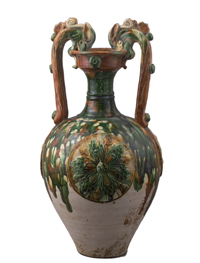 |
重要文化財 三彩貼花龍耳瓶 唐時代・8世紀 横河民輔氏寄贈 華やかな色彩と西方の影響を匂わす独特の器形が目をひきます。 名品と名高い唐三彩の作品です。 (展示期間:2013年1月2日(水)~5月6日(月・休) 5室) |
![]() 「中国の陶磁」展示作品リストへ
「中国の陶磁」展示作品リストへ
![]() 「中国 墳墓の世界」展示作品リストへ
「中国 墳墓の世界」展示作品リストへ
中国の漆工中国の漆工は新石器時代にさかのぼる歴史をもちます。その装飾技法として、塗り重ねた漆を彫刻する彫漆、貝殻を成形して貼付する螺鈿、漆器に文様を彫って金を充填する鎗金(そうきん)、文様部を色漆であらわし線彫りの 輪郭をほどこす存星(ぞんせい)などがあります。文様も、山水・花鳥・楼閣・人物などの絵画的文様や、唐草文様が発達 した屈輪(ぐり)のほか、黒漆や朱漆のみで器形を美しく表現する無文漆器などがあります。多種多様な中国漆工の世界をご覧ください。
|
 |
 |
|
|
楼閣人物堆黒盆 |
重要文化財 龍濤螺鈿稜花盆 |
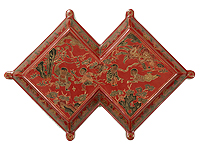 |
童子存星方勝形合子 「大明嘉靖年製」銘 明時代・嘉靖年間(1522~66) 四角を繋いだ方勝とよばれる形の箱。 蓋表には子供たちが遊ぶ様子をカラフルに表しています。 (展示期間:2013年1月2日(水)~3月24日(日) 9室) |
西域の美術中国の玉門関(ぎょくもんかん)より西、タクラマカン砂漠の南北に点在するトルファン、クチャ、ホータンなどは、かつて仏教寺院が建ち並び、ラクダに荷を載せた隊商が停泊するオアシスでした。19世紀、これらの地に仏教の源流を求める目的で探検したのが大谷光瑞(おおたにこうずい)です。当館の西域コレクションはほぼ大谷探検隊がもたらしたものです。玄奘三蔵をはじめとする多くの僧、商人が往来した地域の遺品を見ることができる大変興味深い展示室です。 |
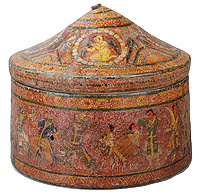 |
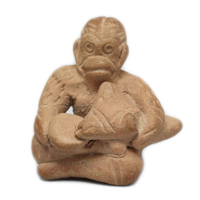 |
|
| 舎利容器 6~7世紀 中国・スバシあるいはクムトラ石窟 大谷探検隊将来品 直径38センチある大型の舎利容器。蓋には翼のある天使が、身の周囲には楽器を演奏し、仮面をつけて踊る人々が描かれています。 (展示期間:2013年1月2日(水)~2月24日(日) 3室)
|
物を抱えて坐るサル (テラコッタ小像及破片のうち) 1~4世紀 中国・ヨートカン出土 大谷探検隊将来品 粘土を焼いて作った高さ2cmほどのサルの人形。ホータン国の首都 ヨートカンからはこのような小さな人形が多数出土しています。 (展示期間:2013年1月2日(水)~2月24日(日) 3室) |
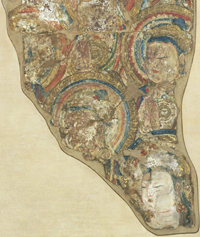 |
仏説法図(部分) 高昌ウイグル期時代・10~11世紀 中国・ベゼクリク石窟 大谷探検隊将来品 トルファンの北東に造営されたベゼクリク石窟の壁画。金箔と鮮やかな彩色で菩薩の群像が描かれています。 (展示期間:2013年1月2日(水)~2月24日(日) 3室) |

